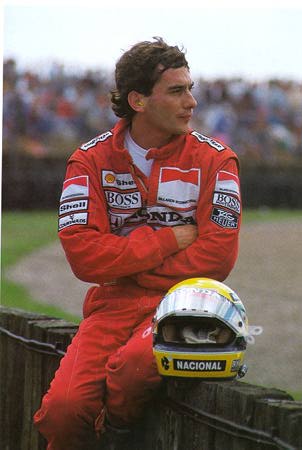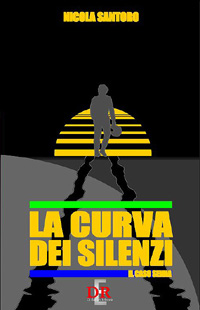|
Nicola Santoro, a young journalist that covered the Senna trial for various Italian publications, published a book about the great Brazilian's death, and the trial that followed. Atlas F1 gives the floor to Santoro, as he presents his work and how it all began
Ayrton Senna was not only a great driver, perhaps the greatest: he was a living myth. This was a man who fascinated millions of people of all ages and backgrounds, even those far from the world of racing.
 He was an ideal, a flagbearer for a poor country, who was able to show his great talent and to gratify his obsession with success in a rough and unforgiving world, one that was light years from every day reality. He was an ideal, a flagbearer for a poor country, who was able to show his great talent and to gratify his obsession with success in a rough and unforgiving world, one that was light years from every day reality.
Serious, well mannered, down to earth and so seemingly normal, Senna had a facility with words and such a positive presence, that he was immediately liked. Once in his car, he would transform into a phenomena: one that enchanted everyone for his easy control and the timing he achieved without ever appearing to strain himself. He had an elegant way of driving: aggressive, but with incredible precision. With his 65 pole positions, it seemed that nothing could stop him. For those who love the Grand Prix, his victories in the early 90ís seemed mortgaged from a youth committed to show that he was the best: to his opponents, the world and most of all, to himself.
In the business of the sport, he was a professional light years beyond the others. He presented his image brilliantly, gained profit from his ventures and was able to break through the barrier that normally separated race car enthusiasts from the rest of the world. He was famous everywhere. According to professional surveys, he was as popular as the Beatles, Clinton and Pele. His name was synonomous with race car driving.
Senna's unexpected and inexplicable death came as he drove the finest car towards victory in yet another Grand Prix. It came at a time when he was close to being crowned prince of racing, and made a myth of the only driver capable of living his own legend.
Four years have passed and the myth is untouched. Neither the passage of time nor the arrival of new figures imposed by mass media can alter his fame.
Senna continues to create a stir: merchandise bearing his name makes millions; the numerous publications about him continue to sell hundreds of thousands of copies, the charities carrying his name are flourishing. These latter continue to help poor children and to transmit the champion's positive message.
But today, instead of victories, it is Senna's trial and the unsolved mysteries surrounding his death that draw the attention of the media, fans and the common reader. It was a long, complicated and difficult trial that could place in jeopardy a dangerous sport. The Formula One has sixteen dangerous appointments in eleven countries each year. The tracks differ not only geographically but also, and more importantly, juridically. Faced wih a tragedy like that at Imola in May 1994 - two men dead and a string of serious accidents - the very sport is questioned. Everything from the danger to the utility of improved techniques and the intangible legalities must be examined.
Senna's trial provoked great controversy. The International Automobile Federation threatened to withdraw from races in Italy. The teams were opposed to a homicide trial, maintaining that the risks of the race are well known and accepted by its protagonists. What could have been a simple search for facts and the truth of what happened that May afternoon at Imola, became an international case. The case was made even more interesting by the doubts and questions that emerged in hearings where great figures like Damon Hill and Frank Williams testified; details about a world so ascetic and distant as to seem incomprehensible.
Why did Ayrton Senna go off the fastest place in the track at Imola when he was leading in his 160th Grand Prix? Why did he die? What happened to his car? Did the steering column give way? People continue to ask themselves these questions and leading journalists from all over the world try to address them in weekly articles and news services.
A technical-juridical fact that might have been reported at the bottom of a page of a sport's magazine has become a regular news event that has been researched, fathomed and analysed from every possible viewpoint. Already, there is talk of a film about the trial of the great Brasilian champion.
My book - "The Curve of Silence" - is more about the trial than the man. Everything possible has already been written about Senna's exploits in the world of sport, but this trial is special. It is fascinating, full of questions and mysteries that render it interesting even to the layman, the common reader who would like to understand the detective story surrounding the death of a great personage. One enters into a rich and fascinating world, filled with light, sound and color, behind which are hidden many shadows.
A book on Senna risks being a book for fans only - a classic for the sports section of a bookstore - a book exalting the pilot-athlete and written for those who love races and motors.
A book on the trial addressed to "Frank Williams and others" on the death of a great contemporary man like Ayrton Senna is different. Here the story of an event that has perturbed public opinion is recounted, a story that continues to make news and that reveals to the ordinary person the mysteries of a particular environment in which the conditions for a tragedy developed.
The style of the book is journalistic: facts are recounted and are given both a context of time and place and a historical framework. As well as the facts, the emotions surrounding the trial and the reactions of many people, especially those of young people who grew up with the myth of Ayrton Senna are described.
The book introduces the people who were with Senna at his death and at the trial. They ask the most common and fundamental questions and try hard to give answers based on a careful analysis of the facts and the trial elements. We learn the truth and doubts that gradually become certainty, see the events as they unfold, the hearings that follow and the facts that emerge from the trial procedings.
I have followed the great driver closely and consider him to be one of the inspirational men of our time. The desire to know what happened, to be closer to my hero and to penetrate a world normally seen from a distance drove me to the intensive research needed to follow the trial, almost as a personal and indirect homage to the memory of this man.
The book recounts the experience of the trial: the details that emerge from the hearings, the facts and the behind the scenes events. To give structure to the story, there is a supposition about what might have happened, on the causes of the accident. This is gradually confirmed during the course of the hearings and much research. Gradually a solid theory emerges: Senna's death was a fatality due to a chain of unfavorable events that precede and go beyond the actual accident.
There are no big revelations nor clamorous scoops in the book. It is a careful, precise and methodic narration of the events followed by reflections that tie together the details and reveal to the reader the backstage of this unique world. It is a world made up of exciting people and situations from every corner of the planet who have a sole objective in the Grand Prix: Victory. That desire for victory was Senna's goal and could be seen in every move he made: from every detail of his life story one sees that it is the only real motivation that drives one in such a difficult and tiring environment. The days are impossible, filled with jet-lag from world-wide travel and the constant peril behind the magic of the race. That peril that Ayrton Senna seemed to look at from a far, in the end snatched him from his myriad fans and placed him in the history books of sport.
About The Author
 Nicola Santoro was born in Rome, 28 years ago. Fascinated by racing since he was very young, at 18 he began racing in the Formula Ford category, the one that Ayrton Senna dominated in the early l980's. At 20 Santoro started working as an editor for the auto racing section of the newspaper "Paese Sera", where he also covered the Grand Prix racing. He has been a member of the order of journalists since 1991. He has written for many publications including the newspapers, "Il Giornale", "Il Lungianese", "ROMBO Auto and Sport" and "Auto" magazines ,and the television programs, "Racing Time" and "Moto". Nicola Santoro was born in Rome, 28 years ago. Fascinated by racing since he was very young, at 18 he began racing in the Formula Ford category, the one that Ayrton Senna dominated in the early l980's. At 20 Santoro started working as an editor for the auto racing section of the newspaper "Paese Sera", where he also covered the Grand Prix racing. He has been a member of the order of journalists since 1991. He has written for many publications including the newspapers, "Il Giornale", "Il Lungianese", "ROMBO Auto and Sport" and "Auto" magazines ,and the television programs, "Racing Time" and "Moto".
He has a law degree from the University of Rome "La Sapienza" with a thesis written on Criminal Law. He divides his time between work at the criminal court of Rome and intense journalistic activity. In 1997 he represented the newspaper "Il Giornale" and the magazine "Rombo Auto and Sport" as well as private radio stations at the trial following the death of Ayrton Senna.
| 
